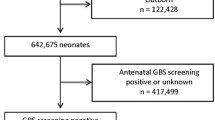Abstract
Objective
Group B Streptococcus (GBS) early onset disease is a major cause for neonatal morbidity and mortality. We aimed to determine whether maternal GBS and the associated intrapartum antibiotic prophylaxis impacts pediatric long-term respiratory infectious morbidity.
Study design
A population-based cohort study was conducted, during the years 1991–2013, comparing the incidence of hospitalizations due to common respiratory infections (RI) in offspring of mothers with and without GBS. Univariate analysis and a Cox proportional hazard model were used to estimate un-adjusted and adjusted hazard ratios for pediatric RI risk.
Results
During the study period, 173,757 term vaginal deliveries took place, of which 2.4% (4252) were diagnosed as GBS + gravidas. In univariate and multivariate analyses for the entire study period, RI risk was increased in exposed offspring. In a sensitivity analysis investigating study periods with different health policies, both GBS diagnosis rates and pediatric infectious respiratory morbidity rates increased over time, but with no independent association between the two.
Conclusion
When analyzing large data sets spanning over long time periods, a special attention must be paid to account for healthcare trends, to avoid erroneous conclusions, as demonstrated here.

Similar content being viewed by others
References
Foxman B, Gillespie BW, Manning SD, Marrs CF (2007) Risk factors for group B Streptococcal colonization: potential for different transmission systems by capsular type. Ann Epidemiol 17:854–862
Dillon HC, Gray E, Pass MA, Gray BM (1982) Anorectal and vaginal carriage of group B Streptococci during pregnancy. J Infect Dis 145:794–799
Hastings MJG, Easmon CSF, Neill J et al (1986) Group B streptococcal colonisation and the outcome of pregnancy. J Infect 12:23–29
Steer PJ, Plumb J (2011) Myth: Group B streptococcal infection in pregnancy: comprehended and conquered. Semin Fetal Neonatal Med 16:254–258
Prevention of Perinatal Group B Streptococcal Disease. https://www.cdc.gov/mmwr/preview/mmwrhtml/rr5111a1.htm. Accessed 27 Nov 2019
Azad M, Konya T, Persaud R et al (2016) Impact of maternal intrapartum antibiotics, method of birth and breastfeeding on gut microbiota during the first year of life: a prospective cohort study. BJOG An Int J Obstet Gynaecol 123:983–993
Schrag SJ, Zywicki S, Farley MM et al (2000) Group B streptococcal disease in the era of intrapartum antibiotic prophylaxis. N Engl J Med 342:15–20
Keski-Nisula L, Kyinen HR, Karkkainen U et al (2013) Maternal intrapartum antibiotics and decreased vertical transmission of Lactobacillus to neonates during birth. Acta Paediatr Int J Paediatr 102:480–485
Bisgaard H, Hermansen MN, Buchvald F et al (2007) Childhood asthma after bacterial colonization of the airway in neonates. N Engl J Med 357:1487–1495
Heikkinen T (2016) Respiratory viruses and children. J Infect 72:S29–S33
Haimov-Kochman R, Bromiker R, Milwidsky A (2000) Prevention of perinatal group B Streptococcus disease in light of an unknown maternal carriage rate in Israel. Harefuah 138:1040–1043
Marchaim D, Hallak M, Gortzak-Uzan L et al (2000) Risk factors for carriage of group B streptococcus in Southern Israel. IMAJ 5:646–648
Marchaim D, Hallak M, Gortzak-Uzan L et al (2003) Cell wall proteins of group B Streptococcus and low incidence of neonatal disease in southern Israel. J Reprod Med 48:697–702
Sigaúque B, Kobayashi M, Vubil D et al (2018) Invasive bacterial disease trends and characterization of group B streptococcal isolates among young infants in southern Mozambique, 2001–2015. PLoS ONE 13:e0191193
CBS (2018) Localities and population, by population group, district, sub-district and natural region. Central Bureau of Statistics, Israel. https://www.cbs.gov.il/he/publications/DocLib/2018/2.%20ShnatonPopulation/st02_17.pdf. Accessed 27 Nov 2019
Rosner B (2011) Fundamentals of biostatistics, 7th edn. Brooks/Cole, Boston
Hoenig JM, Heisey DM (2001) The abuse of power: the pervasive fallacy of power calculations for data analysis. Am Stat 55:1–6
Goodman SN, Berlin JA, Johns F (1994) The use of predicted confidence intervals when planning experiments and the misuse of power when interpreting results. Ann Intern Med 121:200–206
Tasher D, Rubin L, Grossman Z et al (2016) Child health care in Israel. J Pediatr 177S:S107–S115
Sefty H, Freedman A, Shohat T (2017) Incidence of Group B streptococcus neonatal invasive infections, Israel (2010–2016). ICDC-Israel Cent Dis Control Minist Heal
Author information
Authors and Affiliations
Contributions
GS conceived the idea and wrote the first draft with substantial contributions from SE and WA. GS, SE, WT, SI, SR, and WA planned and carried out the analyses. WA supervised the project. All authors listed have approved the final version.
Corresponding author
Ethics declarations
Conflict of interest
The authors declare that they have no conflicts of interest.
Ethics approval
The study was approved by the local Institutional Review Board (SUMC IRB #0438–15-SOR approved on March 8th 2016).
Informed consent
Due to study design, a waiver of informed consent was granted by the Institutional Review Board (SUMC IRB #0438–15-SOR approved on March 8th 2016).
Additional information
Publisher's Note
Springer Nature remains neutral with regard to jurisdictional claims in published maps and institutional affiliations.
Electronic supplementary material
Below is the link to the electronic supplementary material.
Rights and permissions
About this article
Cite this article
Greenbaum, S., Sheiner, E., Wainstock, T. et al. Group B Streptococcus maternal colonization and respiratory infections in the offspring: lessons learned from an analysis of a population-based cohort with 18-year follow-up. Arch Gynecol Obstet 301, 101–106 (2020). https://doi.org/10.1007/s00404-019-05397-1
Received:
Accepted:
Published:
Issue Date:
DOI: https://doi.org/10.1007/s00404-019-05397-1




